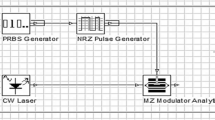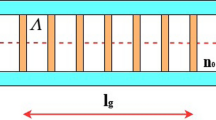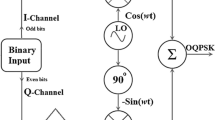Abstract
This study focuses on compensating chromatic dispersion affecting the propagated signal in a standard single mode optical fibers (SSMFs). We propose a model that consists of an identical four stages cascaded linear chirped apodized fiber Bragg gratings (CFBGs) in a post-compensation scheme under Maximum Time Division Multiplexing (MTDM) technique. MTDM is free of the limitations resulting from the fiber nonlinear effects. It, thus, effectively utilizes optical wavelength and operating in various network of different distances and capacities. Therefore, MTDM is designed to be used in the high-capacity and high-speed transmission systems. The evaluation of the proposed model performance is performed through a comparative study using different connections and the most common apodization functions. This comparative study includes three cases based on the used connection scheme. A 10 Gbps Wavelength Division Multiplexing (WDM) 70 km link is simulated under ordinary operating parameters. Optisystem 7.0 is used for the simulation and evaluation process, in terms of two metrics which are quality factor (Q-factor) and bit error rate (BER). In the pre-compensation scheme, the highest results are: Q-factor = 7.664 and BER = 8.99 × 10–15, using the raised cosine apodization function. Using the raised sine apodization in the post-compensation connection realizes the best performance: Q-factor = 8.58 and BER = 4.77 × 10–18. In the symmetrical-compensation scheme and using the raised sine apodization, the proposed model attains the highest Results: Q-factor = 7.49 and BER = 3.53 × 10–14. The proposed model achieves at least 92.6% improvement in BER and 3.75% in Q-factor over the related works. The study is a simulation work and is performed through Optisystem ver. 7.
Similar content being viewed by others
Avoid common mistakes on your manuscript.
1 Introduction
The propagated signal through an optical fiber suffers many propagation problems; attenuation and dispersion. Attenuation is the reduction of propagated signal power with distance (Mustafa 2021). The attenuation problem has been solved by the development of optical fiber amplifiers, such as erbium doped fiber amplifier (EDFA). The chromatic dispersion is considered as the main obstacle to enhance the performance of the optical fiber communication system (Ibarra-Villalon 2021). Chromatic dispersion is the pulse broadening due to the dependency of core refractive index on the propagated signal wavelength (Meena 2020). This makes different wavelengths propagate with different velocities, which leads to group velocity delay (GVD). These pulses overlap together and cause in the worst case intersymbol interference (ISI) at the receiver side. Also, dispersion decreases transmission bit rate and the overall system performance (Dahir 2020). To solve this, researches developed many dispersion compensation (DC) techniques; FBG is one of the most efficient one of them (Smith 1997).
There are two types of FBG according to the spatial gratings distribution. These are uniform FGB and chirped FBG (CFBG) (Dar 2017). In uniform FGB, the gratings are equal distant while in CFBG they are unequal distant. The gratings refractive index depends on the propagated signal wavelength in the case of uniform FBG (Toba 2019). A small amount of the optical signal propagating through FBG is totally reflected at a certain wavelength which is called Bragg wavelength, λB (Sayed 2020). The other wavelengths are transparent to FBG except some sidelobes which distort the output reflected signal. These sidelobes can be suppressed using apodization. The key operation principle of FBG in compensation mode is minimizing the full width at half maximum (FWHM). To do that, one can use a chain of n-stages cascaded FBG (Hussein 2019). This number is selected to provide the required FWHM at an acceptable power reflectivity.
There are many other factors that affect the signal propagation through the optical fiber communication systems. Such as, transmission techniques, modulation and multiplexing schemes (Khalaf 2021).
In this work, we use MTDM with FBG to enhance the overall system performance. The aim of this work is to enhance the overall optical fiber communication system performance by enhancing the chromatic dispersion compensation in SSMF. MTDM is designed to accomplish the high-capacity and high-speed transmission. Being able to adopt nonlinear soliton transmission and other useful technologies, MTDM can eliminate the effect of chromatic dispersion in the high-speed transmission. At the same time, MTDM is able to eliminate the rate effect of electronic devices to accomplish the high-speed transmission on a single wavelength. As an effectively optical multiplexing way, MTDM can make full use of spectral resources and greatly improves the utilization of spectral bandwidth. Unlike WDM, MTDM is free of the limitations resulted from the nonlinear effect of fibers, thus effectively utilizing optical wavelength and operating in various network of different distances and capacities. Though still immature, MTDM is a more long-term technology than WDM.
We propose a compensation model consisting of four identical stages cascaded apodized linear CFBG in the post-compensation connection scheme. It is based on the MTDM transmission technique. The model is simulated by using Optisystem 7, and is evaluated through a comparative study in terms of Q-factor and BER. In this study, the most common apodization functions and connection schemes (i.e., pre, post and symmetrical schemes) are investigated. The simulated system is connected in a 10 Gbps WDM link under a set of practical operational parameters. Using this proposal, the simulation is performed through Optisystem ver. 7.
The rest of this paper is organized as follows. The basic model and analysis are illustrated in Sect. 2. Section 3 explains the proposed model. The simulation results are displayed and discussed in Sect. 4. Section 5 is devoted to the main conclusions.
2 Basic model and analysis
2.1 Principles of FBG
The key idea of FBG is based on Fresnel reflection principle, where a propagated optical signal through a medium with different refractive indices can be reflected or refracted at the interface (Aly 2021). Uniform FGB is the basic type of FBG, where the gratings are equidistant along the core axis.
The relation between the Bragg wavelength, \({\lambda }_{\text{B}}\), and the grating periodicity, \({\Lambda}\), is given by (Sharma 2018)
where neff is the core effective refractive index.
In uniform FBG, the refractive index modulation through the core axis is given by (Sharma 2018)
where Δn0 is the maximum index variation and nd(z) is the index variation function.
The index modulation depth variation has a great impact on sidelobes peaks. The reflected spectrum of FBG with a uniform modulation has a significant undesirable sidelobes. To solve this issue, apodized index modulation is used (Mustafa 2021).
2.1.1 Chirped FBG and apodization
Chirped FBG is an FBG with unequal gratings period, where it varies along the core axis z. Therefore, the refractive index modulation varies along the grating length and the chirp pattern is defined by l(z). Figure 1 illustrates CFBG structure (Sonne 2021).
From Fig. 1, one can notice that each grating reflects a different Bragg wavelength or it works as a filter bank.
In CFBG, the Bragg wavelength varies along the propagation axis (i.e., λB(z)) according to (El-Gammal 2015)
where Ʌ(z) is the grating period along the propagation axis.
The modulated refractive index n(z) is given by (El-Gammal 2015)
where d(z) is the selected apodization function, Ʌ0 is the first grating period, and x is the chirp parameter.
-
As the case of uniform FBG, sidelobes cause a great problem in CFBG. Therefore, apodized CFBG is used to suppress these sidelobes.
(Ghosh 2018).
In the apodized CFBG, the refractive index modulation is reshaped (i.e., apodized). There are many apodization functions, d(z), with different characteristics. Here, we study the most common apodization functions, see Table 1.
where \(0\ll z\ll {l}_{g}\).
Figure 2 illustrates the used apodization functions at different grating lengths.
Using apodized CFBG as a chromatic dispersion compensator relies on introducing a time delay that is a function of wavelength. The CFBG chromatic dispersion coefficient is given by (Sharshar 2013)
where v is the speed of light, and Δλ is the wavelengths difference between the grating two ends calculated by (Sharshar 2013)
2.1.2 Cascaded CFBG
Figure 3 illustrates the basic idea of the cascaded FBGs. It is based on a successive reduction of FWHM through its stages (Abd-Alla 2010).
In operation, the input of the first CFBG stage is the output from the optical transmitter. Then, the reflected part of the first stage is lunched into the input port of the second CFBG stage. This process proceeds to the last stage (Abd-Alla 2010). The output of the 4-stages cascaded CFBG is the reflected signal of the fourth one. A standard optical circulator is used with each CFBG stage. To compensate the chromatic dispersion, a four cascaded CFBG is used where this number achieves the optimal values of FWHM and reflectivity.
2.2 MTDM transmission technique
The objective of WDM technology is achieving a high transmission bit rate. The maximum bit rates are determined by numerous factors, including the signal modulation rate, the transmission bandwidth, and the response time of the optoelectronic devices. Therefore, the total pulse broadening, Δτ, due to the first order dispersion that limits the bit rates in MTDM-based communication system can be expressed as (Khalaf 2021)
where ∆λ is the FWHM, L is the transmission distance, and Dt is the total chromatic dispersion parameter.
The MTDM transmission bit rate for a WDM link is given by (Khalaf 2021)
3 Proposed model
The proposed model aims to enhance the overall optical fiber communication system performance by compensating the chromatic dispersion in SSMF. We propose a compensation model that includes identical four stages cascaded linear apodized CFBG in post-compensation connection scheme, see Fig. 4. It is based on the MTDM transmission technique.
The reflected signal of the last stage which is the final output of the cascaded CFBG detected by the PIN photodiode. The output of photodiode is an electrical signal which passes through a low pass Bessel filter to recover the required signal. Optisystem 7.0 is used in simulation for the 10 Gbps WDM link. Through a comparative study, the proposed model performance is evaluated in terms of two metrics (Q-factor and BER). Figure 5 shows the study procedure.
The comparative study includes three cases based on the used connection scheme (i.e. pre, post or symmetrical compensation). Under each connection scheme, we apply, in one-by-one manner, all the most common apodization functions shown in Table 1.
4 Results and discussion
This study focuses on enhancing the optical communication system performance using MTDM transmission technique and four identical stages cascaded apodized linear CFBGs. Each case has six sub-cases based on the used apodization function. Table 2 displays the simulation parameters. These parameters are the normal and most used parameters in the optical fiber communication field.
4.1 Case one: pre-compensation model
Figure 6 illustrates the structure of the proposed model in pre-compensation scheme.
It is found that, in Gaussian and tanh cases, the signal is totally lost (i.e. Q-factor of 0 and BER of 1). Table 3 illustrates the other sub-cases results.
The raised cosine apodization gives the best results: Q-factor = 7.66 and BER = 8.99 × 10− 15. Figure 7 shows the Q-factor and BER of the raised cosine apodization.
4.2 Case two: post-compensation model
The basic structure of the post-compensation scheme of case two is shown in Fig. 8.
The signal is totally lost in Gaussian sub-case. The results of the other apodization functions are summarized in Table 4.
4.3 Case three: symmetrical-compensation model
The symmetrical compensation scheme structure is shown in Fig. 10.
Again, in Gaussian and tanh cases the signal is totally lost. Table 5 illustrates the results of case three for the remaining apodization functions.
The raised sine apodization gives the best results: Q-factor = 7.49 and BER = 3.5 × 10− 14. Figure 11 shows the Q-factor and BER of the raised sine apodization.
4.4 Comparison with related (published) work
In this section, we compare our proposed model results with related works, see Table 6.
One can note the superiority of our results as compared with the previous published works.
5 Conclusion
We proposed a model that consists of a 4-identical stages of cascaded apodized linear CFBGs in three connection schemes. MTDM transmission technique is applied on the proposed model. Through a comparative study with different apodization functions and connection schemes the model performance is evaluated, in terms of two metrics (i.e., Q-factor and BER). The proposed model achieves the highest results in the pre-compensation scheme: Q-factor = 7.664 and BER = 8.99 × 10− 15, using the raised cosine apodization function. Using the raised sine apodization in the post-compensation connection realizes the best performance: Q-factor = 8.58 and BER = 4.77 × 10− 18. In the symmetrical-compensation scheme and using the raised sine apodization, the proposed model attains the highest results: Q-factor = 7.49 and BER = 3.53 × 10− 14. The proposed model achieves at least 93% improvement over the related studies.
References
Abd-Alla, M.I., Houssien, F.M.: Improvement of the performance of advanced local area optical communication networks by reduction the effects of the propagation problems,“. Int. J. Comput. Sci. Inform. Technol. 1(3), 147–157 (2010)
Aly, M.H., Mustafa, F.M., Abdelhalim, M.M., Barakat, T.M.: Dispersion compensation analysis of optical fiber link using cascaded apodized FBGs hybrid with maximum time division multiplexing transmission technique,. Opt. Quant. Electron. 53(7), 1–21 (2021)
Dar, A.B., Jha, R.K.: Chromatic dispersion compensation techniques and characterization of fiber Bragg grating for dispersion compensation. Opt. Quant. Electron. 49(108), 1–35 (2017)
Dahir, A.A., Yu, Z.: “Dispersion compensation by using FBG and low pass Gaussian filter,” In 2020 IEEE 5th International Conference on Computer and Communication Systems (ICCCS), Shanghai, China, pp. 803–806, 15–18 May, (2020)
El-Gammal, H.M., Fayed., H.A., Abd El-Aziz, A., Aly, M.H.: “Performance analysis and comparative study of uniform, apodized and Pi-phase shifted FBGs for array of high performance temperature sensors,“ Optoelectronics and Advanced Materials-Rapid Communications, vol. 9, no.9–10, pp. 1251–1259, (2015)
Ghosh, C., Priye, V.: Dispersion compensation in a 24×20 Gbps DWDM system by cascaded chirped FBGs. Optik. 164, 335–344 (2018)
Hussein, T.F., Rizk, M.R., Aly, M.H.: “A hybrid DCF/FBG scheme for dispersion compensation over a 300 km SMF,“. Opt. Quant. Electron. 51(103), 1–16 (2019)
Ibarra-Villalon, H.E., Pottiez, O., Gómez-Vieyra, A., Lauterio-Cruz, J.P., Bracamontes-Rodriguez, Y.E.: “Numerical study of the fiber dispersion contribution in the pulse propagation problem,”European Journal of Physics, vol. 42, no. 2, Article 025303, (2021)
Khalaf, A.A., Sayed, A.F., Mustafa, F.M., Aly, M.H.: Spectral width reduction using apodized cascaded fiber Bragg grating for post-dispersion compensation in WDM optical networks. Photon Netw. Commun. 41(3), 231–241 (2021)
Meena, D., Meena, M.L.: Design and analysis of novel dispersion compensating model with chirp fiber Bragg grating for long-haul transmission system. ” In In: Optical and Wireless Technologies, pp. 29–36. Springer, Singapore (2020)
Mustafa, F.M., Zaky, S.A., Khalaf, A.A., Aly, M.H.: Dispersion compensation in silica doped fiber using soliton transmission technique over cascaded FBG. Opt. Quant. Electron. 53(5), 1–17 (2021)
Sayed, A.F., Mustafa, F.M., Khalaf, A.A., Aly, M.H.: An enhanced WDM optical communication system using a cascaded fiber Bragg grating. Opt. Quant. Electron. 52(3), 1–21 (2020)
Sharma, S., Sharma, A., Thakur, S.: “Comparative analysis of dispersion compensation using electronic dispersion compensation techniques at different bit rates using single mode fiber,“. Int. J. Mech. Prod. Eng. Res. Dev. (IJMPERD). 8(3), 365–373 (2018)
Sharshar, H.A., Rashed, A.N.Z.: Polystyrene plastic and silica-doped optical fibers performance transmission efficiency based on maximum time division multiplexing and soliton propagation techniques,. Int. J. Adv. Res. Electron. Communication Eng. 2(3), 231–238 (2013)
Smith, G.H., Novak, D., Ahmed, Z.: Overcoming chromatic-dispersion effects in fiber-wireless systems incorporating external modulators,. IEEE Trans. Microwave Theory Tech. 45(8), 1410–1415 (1997)
Sonne, A.: “Designing and controlling a single-mode dual concentric core fiber with nearly zero ultra-flattened chromatic dispersion for linear or nonlinear application,“ Optik, vol. 231, Article 166375, (2021)
Toba, M., Mustafa, F.M.: “Theoretic study of cascaded fiber Bragg grating,“. In: Fiber Optic Sensing-Principle, Measurement and Applications, pp. 328–355. IntechOpen (2019). doi:https://doi.org/10.5772/intechopen.78479
Funding
Open access funding provided by The Science, Technology & Innovation Funding Authority (STDF) in cooperation with The Egyptian Knowledge Bank (EKB).
Author information
Authors and Affiliations
Corresponding author
Ethics declarations
Conflicts of interest
We are enclosing herewith a manuscript entitled “Dispersion Compensation Using Cascaded Apodized CFBGs under MTDM Transmission Technique: Enhanced System Performance” for publication in Optical and Quantum Electronics Journal. With the submission of this manuscript I would like to undertake that: • All authors of this research paper have directly participated in the planning, execution, or analysis of this study; • All authors of this paper have read and approved the final version submitted; • The contents of this manuscript have not been copyrighted or published previously; • The contents of this manuscript are not now under consideration for publication elsewhere; • The contents of this manuscript will not be copyrighted, submitted, or published elsewhere, while acceptance by the Journal is under consideration; • There are no directly related manuscripts or abstracts, published or unpublished, by any authors of this paper; • Authors also declare NO conflict of interest.
Additional information
Publisher’s Note
Springer Nature remains neutral with regard to jurisdictional claims in published maps and institutional affiliations.
Rights and permissions
Open Access This article is licensed under a Creative Commons Attribution 4.0 International License, which permits use, sharing, adaptation, distribution and reproduction in any medium or format, as long as you give appropriate credit to the original author(s) and the source, provide a link to the Creative Commons licence, and indicate if changes were made. The images or other third party material in this article are included in the article’s Creative Commons licence, unless indicated otherwise in a credit line to the material. If material is not included in the article’s Creative Commons licence and your intended use is not permitted by statutory regulation or exceeds the permitted use, you will need to obtain permission directly from the copyright holder. To view a copy of this licence, visit http://creativecommons.org/licenses/by/4.0/.
About this article
Cite this article
Mustafa, F.M., Mohamed, A., Khalaf, A.A.M. et al. Dispersion compensation using cascaded apodized CFBGs under MTDM transmission technique: Enhanced system performance. Opt Quant Electron 55, 32 (2023). https://doi.org/10.1007/s11082-022-04132-6
Received:
Accepted:
Published:
DOI: https://doi.org/10.1007/s11082-022-04132-6















